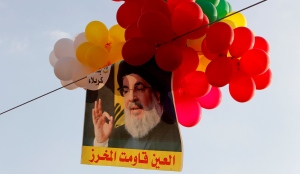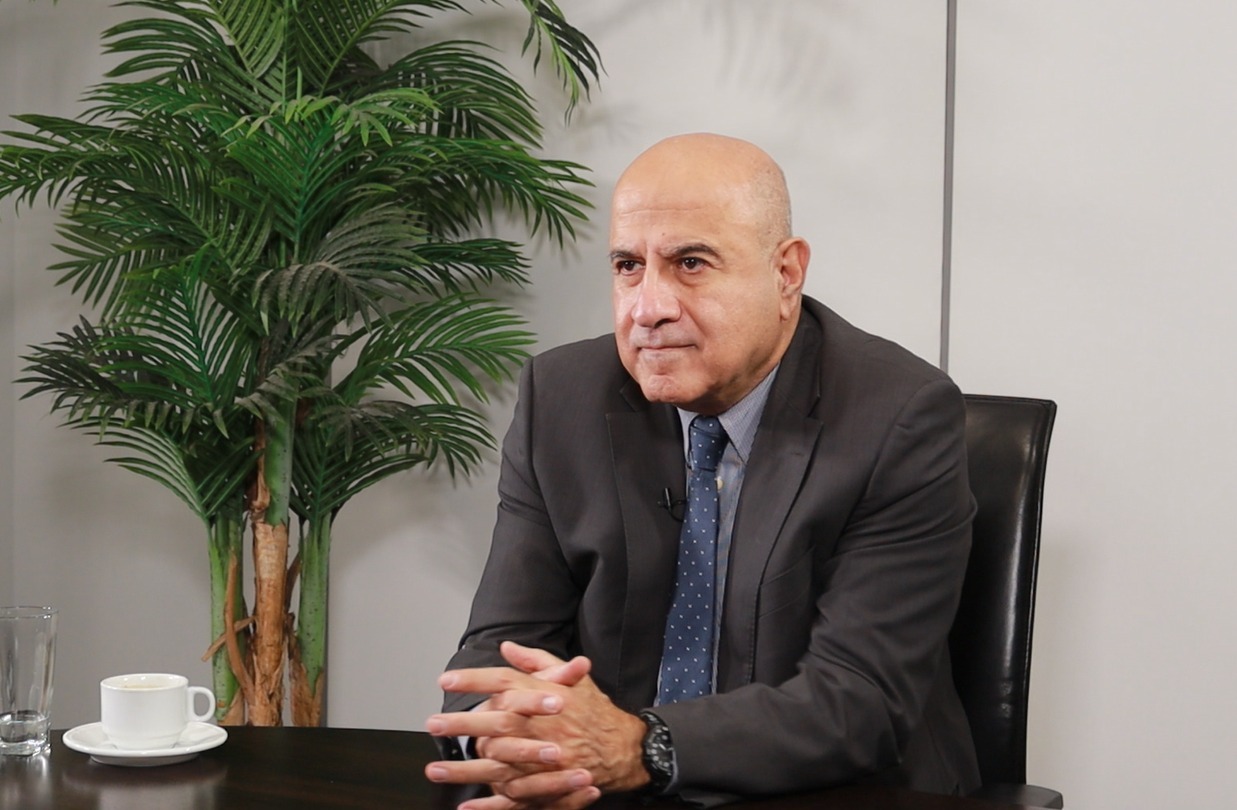Analysis/Israel Broke the Rules of the Game With Hezbollah, and Now the Ball Is in Nasrallah’s Court
عاموس هاريل/هآرتس: إسرائيل اسقطت قواعد اللعبة مع حزب الله والكرة الآن هي في ملعب نصرالله
Amos Harel/Haaretz/August 26/2019
The strike in Syria, the mysterious incident in Lebanon and reports on attacks on Iraqi border: In 24 hours a serious escalation between Israel and Iran got underway. But in the short term, the real threat may actually not come from Tehran.
The series of incidents that occurred across the Middle East over the last 24 hours represents a significant escalation in Israel’s battle with Iran. Judging by media reports, this conflict – most of which is still being waged covertly – now encompasses three other countries: Syria, Lebanon and Iraq.
Over the past day, three attacks in these three countries have been attributed to Israel, all against targets connected to Iran. In two of them, in Syria and Iraq, casualties were reported. And since Hezbollah Secretary General Hassan Nasrallah has explicitly threatened vengeance for the death of his people in the Syrian incident, the unusually high alert in Israel is expected to continue for some time.
At about midnight Saturday night, the Israel Defense Forces announced that it had thwarted an Iranian plan that included launching attack drones at military targets and civilian infrastructure in northern Israel. The first attempt by the Iranian Revolutionary Guards’ Quds Force was thwarted on Thursday, when the Iranians, accompanied by Shi’ite militiamen, approached the Israeli border in the Golan Heights. The IDF hasn’t elaborated on how this plan was thwarted, but it did publish photos that showed the operatives near the border.
Yet the Iranians evidently didn’t give up. Saturday night, Israel’s air force struck a building in Aqraba, southeast of Damascus, from which the drone attack was slated to be launched, apparently a few hours later. The IDF says the building served the Quds Force and Shi’ite militiamen and housed drones and explosives that had been sent from Iran via the Damascus airport.
IDF Chief of Staff Aviv Kochavi accused the Quds Force commander, Gen. Qassem Soleimani, of having financed and planned the operation. Syrian reports said two Hezbollah members were killed in the Israeli strike.
Israel provided unusual detail about the attack. Both the IDF spokesman and Prime Minister Benjamin Netanyahu issued statements. Netanyahu’s office even said he spent the night at air force headquarters together with Kochavi.
Israel thereby broke with the policy of ambiguity it has employed toward most incidents in Syria in recent years, albeit not for the first time. Perhaps it did so because this was a preemptive strike, moments before an Iranian attack. But obviously, electoral considerations may have played a role as well.
Less than three hours later, there was an incident in Beirut. Nasrallah said in his speech that residents of Dahiyyeh, Beirut’s Shi’ite quarter, spotted Israeli drones flying above the neighborhood at low altitude. One was downed by youths throwing stones, he said. Another apparently hit a Hezbollah office in the neighborhood, causing minor damage.
If Israel was behind this attack, it’s not clear what it hoped to achieve, aside from sending Hezbollah a warning. The damage seen in the photos from Dahiyyeh doesn’t justify such an unusual strike. But it’s very possible there are aspects to this incident that we don’t yet know about.
The third incident took place Sunday afternoon, near the Abu Kamal border crossing between Iraq and Syria. A drone reportedly struck a convoy on the Iraqi side of the border that included Shi’ite militia commanders. Iraqi reports said nine people were killed, including a relatively senior local commander.
Earlier on Sunday, Netanyahu and Kochavi toured the Golan Heights and assessed the situation with senior IDF officers. Netanyahu said during this visit that the thwarted attack from Syria was “an Iranian initiative, under Iranian command, in Iran’s service.” He added that Israel won’t tolerate attacks on its territory, and that any country which lets its territory be used to attack Israel will bear the consequences. “If someone rises up to kill you, kill him first,” he said.
Nasrallah responded with a long, aggressive speech in Beirut. He denied Israel’s claim that the strike in Syria targeted Iranian Revolutionary Guards personnel, saying the bombed building actually served Hezbollah operatives. He accused Israel of violating “the rules of the game” and threatened a harsh, immediate response, presumably from Lebanon. “I say to the Israeli soldiers on the border, you should fear our response, starting tonight,” he said.
The defense establishment takes Hezbollah’s threats seriously. Alert levels were raised at Iron Dome batteries in the north and at outposts along the Lebanese and Syrian borders.
Hezbollah has attacked soldiers following similar threats in the past. In 2015, for instance, it fired an antitank missile that killed an officer and a soldier on Har Dov in response to a strike attributed to Israel that killed senior Hezbollah official Jihad Mughniyeh and an Iranian general in the Syrian Golan.
Iran has also tried repeatedly – in April and May 2018 and January 2019 – to retaliate for Israeli attacks on its bases in Syria with missile launches from Syria. But those attempts were thwarted by the air force.
Hezbollah has previously termed Israeli airstrikes in Lebanon a red line, even as it refrained from responding to dozens of attacks attributed to Israel in Syria that targeted convoys ferrying weapons for the organization. Consequently, Israel chose to reveal Hezbollah’s efforts to build factories in Beirut to upgrade the accuracy of its missiles through a public speech at the United Nations rather than airstrikes.
Iranian revenge attempt
The weekend’s thwarted Iranian attack was apparently revenge for a July 19 attack in Iraq. That attack, which was attributed to Israel, targeted arms stockpiled by Iranian-supported Shi’ite militias. Tehran saw this as an Israeli attempt to widen the theater of battle.
America also objected to that strike, fearing it would disrupt its relations with the Iraqi government. Last weekend, U.S. officials leaked details of the operation and criticism of Israel to the New York Times.
Last Thursday, in a sharp deviation from normal information security practices, Tehran even hinted at its expected response. An analyst close to the Revolutionary Guards wrote in the Iranian newspaper Kayhan that Israel’s actions in Iraq and Syria would be answered with surprises such as drone strikes on sensitive military targets, ports and nuclear facilities. The attack the IDF said it thwarted is identical to the one this analyst forecast.
The repeated strikes on Iranian targets in Syria show the advantage the IDF enjoys when its conflict with Iran takes place close to the Israeli border. Israeli intelligence agencies monitor events in Syria closely, and this has so far enabled the air force to hit Iranian targets and thwart Iranian plans without much difficulty.
Nevertheless, Iran hasn’t abandoned its ambitions in Syria. After suffering repeated attacks last year, it altered its deployment (for instance, moving its center of operations from the Damascus airport to the T4 base near Homs, which is farther from Israel). But it didn’t stop trying to entrench itself militarily in Syria, nor did it ends its arms smuggling to Hezbollah.
All this is happening against the background of the tensions between America and Iran in the Persian Gulf and the advancing crisis over America’s withdrawal from the nuclear deal. The Trump administration has made clear that it isn’t interested in war with Iran, but the bilateral friction continues. And Iran can continue attacking oil industry targets in Saudi Arabia and the United Arab Emirates, just as it works against Israel from Syria.
On Sunday, Iranian Foreign Minister Mohammad Javad Zarif unexpectedly visited Biarritz, France where the G7 was meeting. This might be an effort to facilitate negotiations with Washington via European mediators. U.S. President Donald Trump, uncharacteristically, said he had “no comment” when asked about this.
Straw that broke Iranian camel’s back?
The attack in Syria and the incident in Lebanon cast a different light on criticism of Netanyahu over his inaction against Hamas in the Gaza Strip. As proved true last December, with the discovery and destruction of Hezbollah’s cross-border tunnels from Lebanon, it has belatedly emerged that there are other considerations behind Israel’s policy of restraint in Gaza that aren’t always known to the public in real time.
The tension in the north is rising as the election campaign enters the home stretch leading to September 17. Netanyahu is going into the election against the background of a rise in the number of deadly attacks in the West Bank and increasing friction with Hamas in Gaza that could lead to another round of fighting there.
But in the north, unlike in Gaza, Netanyahu currently feels comfortable from a political standpoint. He looks like someone who’s in control of the situation and is employing force relatively cautiously.
For now, residents of northern Israel aren’t feeling threatened or being hurt. Therefore, Netanyahu will presumably try to leverage the military strikes in Syria for electoral purposes, even as he tries insofar as possible to limit discussion of what Israelis living near the Gaza border are suffering.
Regarding the north, Netanyahu’s rivals don’t have a lot to say, aside from somewhat forced expressions of support for the government’s policy and the IDF’s actions. Nevertheless, the unavoidable question is whether the decision to expand Israel’s airstrikes to Iraq (according to media reports) didn’t entail excessive risk, and if this wasn’t the straw that broke the Iranian camel’s back and provoked its attempt to retaliate Saturday night.
When Israel began its airstrikes in Syria several years ago, in the midst of Syria’s civil war, senior defense officials discussed the question of when Syrian President Bashar Assad would get fed up and decide to retaliate for those strikes. Assad restrained himself for a long time, but in 2017, Syrian forces began responding with anti-aircraft fire against Israeli planes. That happened after the regime had regained its confidence by gradually regaining control (with Russian and Iranian help) over most of the country.
The metaphor used at the time was a multi-ride bus ticket: When would enough holes be punched in the ticket for Assad’s patience to wear out? But judging by media reports in recent weeks, Israel has switched from sporadic hole-punching to an unlimited monthly pass. This was presumably unacceptable to Iran, and it will exact a price, even if it won’t necessarily lead to all-out war between the countries.




















